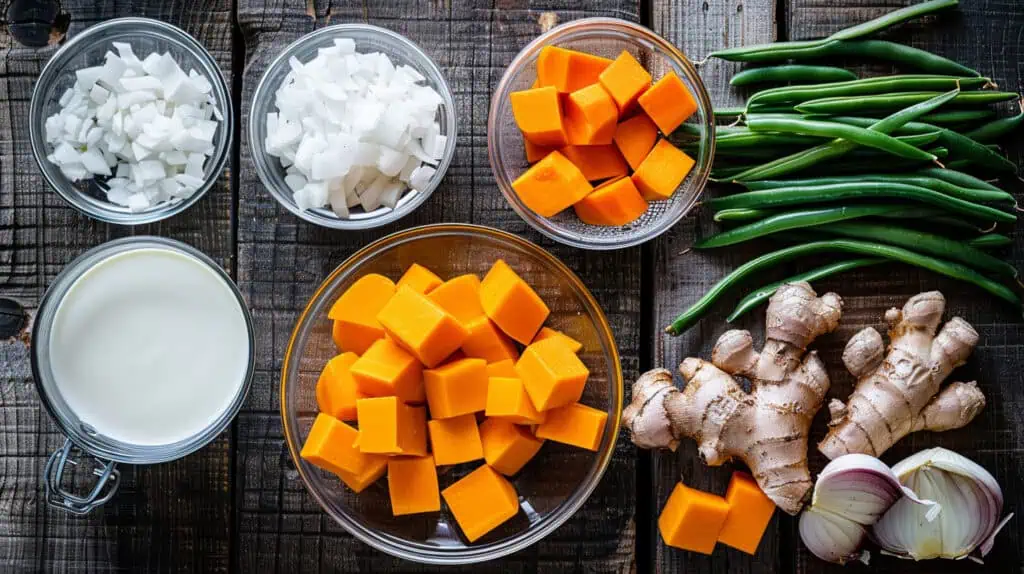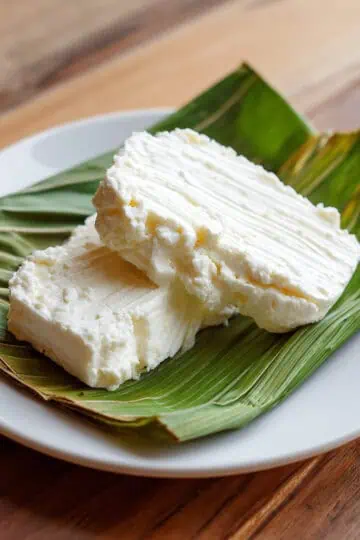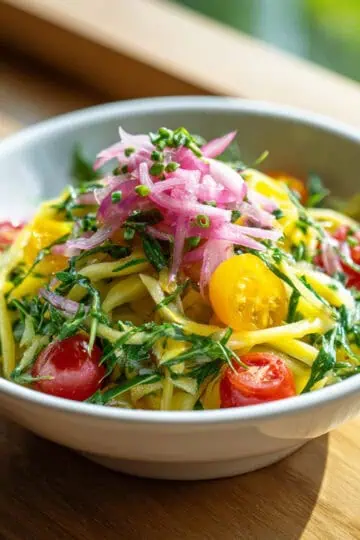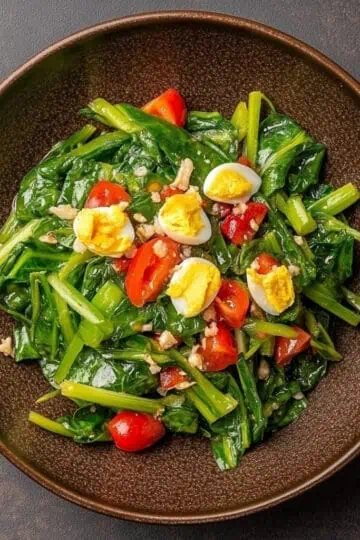I never thought that starting our backyard vegetable garden would reignite my love for Filipino cooking. When our kalabasa vines started producing these beautiful, golden squashes and our sitaw began climbing up their bamboo trellises, I knew I had to master my Lola's famous Ginataang Kalabasa at Sitaw recipe.
This dish holds a special place in my heart, not just because it transforms simple backyard vegetables into a creamy, comforting meal, but because it reminds me of how my grandmother would make it during rainy seasons when fresh produce was scarce in the market.
The way the sweet kalabasa melts into the rich gata, while the sitaw adds that perfect crisp-tender bite, creates pure magic in a pan.
Once you try this ginataang kalabasa at sitaw recipe, you'll understand why this humble vegetable dish has been a Filipino family favorite for generations.
Jump to:

Why You'll Love This Recipe
- Perfect balance of sweet squash and tender string beans in creamy coconut milk
- One-pot meal that's both nutritious and budget-friendly
- Rich in vitamins A and C from fresh vegetables
- Versatile dish that can be made vegetarian or with protein
- Authentic Filipino comfort food that's easy to master
Ingredients
Each ingredient in this Ginataang Kalabasa at Sitaw plays an essential role in creating its distinctive flavor profile. The kalabasa (squash) provides natural sweetness and creamy texture, while sitaw (string beans) adds a fresh crunch.
Coconut milk creates the velvety base that brings everything together, while pork belly contributes savory richness and depth. The aromatics - garlic, onion, and ginger - build a fragrant foundation, and fish sauce adds that perfect umami punch typical of Filipino cuisine.
Together, these simple ingredients create a harmonious dish that showcases the brilliance of Filipino home cooking - transforming everyday vegetables into something truly special.

- 1½ lbs kalabasa (butternut squash/pumpkin) - cubed
- 18 pieces sitaw (string beans) - cut into 2-inch lengths
- 1 piece Knorr Pork cube (seasoning)
- 3 ounces pork belly (liempo) - sliced
- 4 cups gata (coconut milk)
- 1 piece sibuyas (onion) - chopped
- 2 thumbs luya (ginger) - cut into strips
- 5 cloves bawang (garlic) - crushed
- ¼ teaspoon ground black pepper
- 1 tablespoon cooking oil
- Patis (fish sauce) to taste
Equipment
- Large deep pan or kawali (Filipino wok) - For even heat distribution and enough space to simmer all ingredients
- Sharp knife - For efficiently cutting vegetables into uniform pieces
- Wooden spoon or sandok (Filipino ladle) - For gentle stirring without breaking the vegetables
- Measuring cups and spoons - For precise measurements of ingredients
- Chopping board - For safe and clean prep work
- Colander - For washing vegetables thoroughly
- Can opener - If using canned coconut milk

How To Make
- Heat oil in a large deep pan or kawali over medium heat (180°C/350°F). Add sliced pork belly and cook until golden brown and crispy, about 8-10 minutes. This process renders the fat which will add flavor to the dish.
- Using the same pan with rendered pork fat, sauté garlic, onion, and ginger until the onions become translucent and aromatic, about 3-4 minutes.
- Pour in coconut milk and bring to a gentle boil. Reduce heat to medium (160°C/320°F) and simmer for 5 minutes. Be careful not to let it boil too hard to prevent the coconut milk from curdling.
- Add the pork cube and cubed squash. Cook for 5 minutes or until the squash begins to soften. Add the cut string beans and continue cooking for 5-8 minutes until the beans are tender-crisp.
- Season with ground black pepper and fish sauce to taste. Simmer for an additional 2-3 minutes to allow the flavors to meld together.

Tips from Lola's Kitchen
- Never boil coconut milk aggressively - Keep heat medium-low to prevent curdling and separation
- Choose the right squash - Look for one that feels heavy for its size with firm, unblemished skin
- Cut vegetables uniformly - Similar-sized pieces ensure even cooking throughout
- Layer your flavors - Allow each addition to cook properly before adding the next ingredient
- Be patient with the process - Let the coconut milk reduce naturally for a richer taste
- Trust your taste buds - Adjust seasoning gradually, especially when using fish sauce
- Use fresh coconut milk when possible - The flavor difference is worth the extra effort
- Rest before serving - Letting the dish sit for 5-10 minutes allows flavors to fully develop
Substitutions
- Protein options: Chicken pieces, tofu cubes, shrimp, or dried fish can replace pork belly
- Vegetable alternatives: Moringa leaves, eggplant, bitter gourd, or bell peppers work well
- Coconut milk: Canned or powdered coconut milk (diluted as directed) if fresh isn't available
- Pork cube: Shrimp paste, salt, or vegetable bouillon for a vegetarian version
- Ginger: Lemongrass can provide a different but complementary aromatic note
- Fish sauce: Soy sauce or salt can be used, though the flavor profile will change slightly
Troubleshooting
- If too watery: Simmer uncovered to reduce liquid, or add 1-2 tablespoons of mashed squash to thicken
- If too thick: Add warm water or coconut milk gradually, ¼ cup at a time
- If squash is too soft: Add it later in the cooking process or cut larger pieces
- If coconut milk curdles: Lower heat immediately and gently stir until incorporated
- If string beans are too tough: Blanch them briefly before adding to the main dish
- If flavor is too bland: Add fish sauce gradually, allowing it to incorporate before tasting again
- If pork isn't crispy enough: Cook the pork separately until crisp, then add back at the end
Storage & Reheating
- Refrigerator: Store in an airtight container for up to 3 days
- Freezer: Can be frozen for up to 1 month (though texture of vegetables may change)
- Reheating on stovetop: Heat slowly on medium-low, stirring gently to prevent separation
- Reheating in microwave: Heat in 1-minute intervals at 70% power, stirring between intervals
- Reviving texture: Add a splash of fresh coconut milk when reheating to restore creaminess
- Preventing dryness: Cover when reheating to maintain moisture
- Safety note: Always reheat thoroughly to an internal temperature of at least 165°F (74°C)

FAQ
Can I make this dish ahead?
Yes, it actually tastes even better the next day as flavors develop. Store properly and reheat gently.
How do I prevent coconut milk from curdling?
Keep heat medium-low and avoid rapid boiling. Stir gently and consistently.
Is this dish spicy?
The traditional version is mild, but you can add chilies to taste for a Bicol-style heat.
Can I use frozen vegetables?
Fresh is best, but frozen works in a pinch. Thaw completely and adjust cooking time accordingly.
How do I know when the squash is cooked properly?
It should be tender when pierced with a fork but still hold its shape without falling apart.
Is this dish healthy?
Yes! It's packed with vitamins A and C from the vegetables, and moderate in fat. The coconut milk provides healthy fats.
Can I make this completely vegetarian?
Absolutely. Use tofu or mushrooms instead of pork and vegetable stock instead of the pork cube.
What can I serve with Ginataang Kalabasa at Sitaw?
It pairs perfectly with steamed white rice, fried fish, or a simple side salad.
How can I make this dish more filling?
Add more protein like chicken, shrimp, or tofu. Some cooks also add potatoes for extra substance.
Can I use butternut squash instead of kalabasa?
Yes, butternut squash is an excellent substitute and is often easier to find in many grocery stores.
Related
Looking for other recipes like this? Try these:

Ginataang Kalabasa at Sitaw (Squash and String Beans in Coconut Milk)
Equipment
- Large deep pan or kawali (Filipino wok) For even heat distribution
- Sharp knife (kutsilyo) For cutting vegetables
- Wooden spoon or sandok (Filipino ladle) For gentle stirring
- Measuring cups and spoons (Panukat) For precise measurements
- Chopping board (sangkalan) For prep work
- Colander (salaan) For washing vegetables
- Can opener If using canned coconut milk
Ingredients
For the Base:
- 1½ lbs kalabasa butternut squash/pumpkin - cubed
- 18 pieces sitaw string beans - cut into 2-inch lengths
- 1 piece Knorr Pork cube pampalasa/seasoning
- 3 ounces pork belly liempo - sliced
- 4 cups gata coconut milk
For the Aromatics:
- 1 piece sibuyas onion - chopped
- 2 thumbs luya ginger - cut into strips
- 5 cloves bawang garlic - crushed
- ¼ teaspoon ground black pepper paminta
- 1 tablespoon cooking oil
- Patis fish sauce to taste
Instructions
- Start by heating oil in a large deep pan or kawali over medium heat (180°C/350°F). Add sliced pork belly (liempo) and cook until golden brown and crispy (malutong), about 8-10 minutes. This process renders the fat which will add flavor to the dish.
- Using the same pan with rendered pork fat, sauté crushed garlic (bawang), chopped onion (sibuyas), and ginger strips (luya) until the onions become translucent (malinaw) and aromatic, about 3-4 minutes.
- Pour in coconut milk (gata) and bring to a gentle boil. Reduce heat to medium (160°C/320°F) and simmer for 5 minutes. Be careful not to let it boil too hard (huwag pakuluan masyado) to prevent the coconut milk from curdling.
- Add the pork cube (pampalasa) and cubed squash (kalabasa). Cook for 5 minutes or until the squash begins to soften. Add the cut string beans (sitaw) and continue cooking for 5-8 minutes until the beans are tender-crisp (malutong-lutong).
- Season with ground black pepper (paminta) and fish sauce (patis) to taste. Simmer for an additional 2-3 minutes to allow the flavors to meld together. For reheating, warm gently over medium-low heat to prevent the coconut milk from separating.
Tips from Lola's Kitchen
- "Huwag pakuluan masyado ang gata" - Don't let coconut milk boil too hard to prevent curdling
- Use fresh squash that feels heavy for its size
- Cut vegetables in similar sizes for even cooking
- Add chili if you want Bicolano-style heat
- For best results, use fresh, second-press coconut milk for cooking and first-press for finishing
Nutrition
The Story Behind Ginataang Kalabasa at Sitaw
From my family's kitchen in Bataan to the coconut-rich valleys of Bicol, Ginataang Kalabasa at Sitaw tells a story of Filipino ingenuity and resourcefulness. Like many Filipino dishes with gata (coconut milk), this recipe emerged from our ancestors' mastery of the coconut tree - aptly nicknamed the "tree of life" for its countless uses in Filipino culture. While the Bicol region is famous for spicy coconut-based dishes like Bicol Express and Laing, this milder version has become a beloved comfort food across the Philippine archipelago.
The genius of this dish lies in its simplicity. During the rainy season, when leafy vegetables become scarce, hardy kalabasa (squash) and sitaw (string beans) remain reliable garden staples. Our grandmothers discovered that combining these humble vegetables with creamy coconut milk created something extraordinary. The natural sweetness of squash perfectly complements the savory gata, while string beans add a necessary crunch. Adding pork - a practice that likely emerged during the Spanish colonial period - transformed this vegetable dish into a complete meal that could sustain farmers and workers throughout the day.
Today, Ginataang Kalabasa at Sitaw remains a testament to Filipino food wisdom. It's a practical solution to using abundant local ingredients, a nutritious way to get children to eat their vegetables, and a reminder of how our cooking traditions have evolved while staying true to our roots. Whether prepared in modern urban kitchens or traditional provincial homes, this dish continues to bring Filipino families together around the dinner table, proving that the best recipes are often the simplest ones passed down through generations.
This recipe represents what Filipino cooking does best - transforming everyday ingredients into something greater than the sum of its parts. The dish's enduring popularity across regions and generations speaks to its perfect balance of flavors, textures, and nutrients. Whether you're a seasoned cook or just beginning to explore Filipino cuisine, this ginataan recipe offers an authentic taste of Filipino home cooking at its finest.










Teresa says
First off I would like tto say great blog! I
had a quick question that I'd like to ask if you doo not mind.
I was interested to knbow how you create ideas for the recipes???